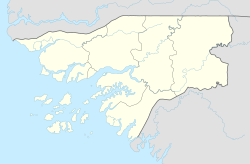Canchungo
| Canchungo | ||
|---|---|---|
|
|
||
| Coordinates | 12 ° 4 ′ N , 16 ° 2 ′ W | |
| Basic data | ||
| Country | Guinea-Bissau | |
| Norte | ||
| region | Cacheu | |
| ISO 3166-2 | GW-CA | |
| surface | 642.9 km² | |
| Residents | 43,709 (2009) | |
| density | 68 Ew. / km² | |
| Culture | ||
| Twin cities | Villach , Porto | |
|
City arms of Teixeira Pinto, today Canchungo
|
||
Canchungo is a city with 11,600 inhabitants (as of 2009) in northwest Guinea-Bissau . It belongs to the administrative region of Cacheu and is located 21 km south of the city of Cacheu and 79 km north of the state capital Bissau .
Canchungo is the seat of the sector of the same name with an area of 643 km² and 43,709 inhabitants.
Until independence in 1974, the city had the colonial place name Vila de Teixeira Pinto , named after the Portuguese colonial officer João Teixeira Pinto (1876-1917).
population
According to the 2009 census, the place had exactly 11,600 inhabitants, with the Manjaco as traditionally the most important ethnic group.
structure
The sector capital Canchungo is divided into eleven, with subdivisions 16 districts ( Bairros ).
The entire Canchungo sector comprises almost 120 localities, often rural villages ( Tabancas ).
The most important places besides the sector capital include:
- Bará (696 inhabitants)
- Beniche (675 inhabitants)
- Cabienque (605 inhabitants)
- Catchobar (1,015 inhabitants in two districts)
- Cuécué (352 inhabitants)
- Jolmete (654 inhabitants)
- Pelundo (2,358 inhabitants in three districts)
- Petabe (719 inhabitants)
- Piss (237 inhabitants)
- Tchulame (607 inhabitants)
Culture and sights
The city is known for its handicrafts, in particular basketry, ceramics and the woven fabrics of the Manjaco .
A large number of buildings from the Portuguese colonial era have been preserved, such as the characteristic water tower from 1946, the church, the school from 1947, the old cinema and former administration buildings. The central avenues are also still in use, with the tall lampposts of the street lighting that is no longer functioning today.
The former monument Teixeira Pintos on the square in one of the two central roundabouts can no longer be seen: the base remained empty after the statue was removed after independence in 1974, the dismantled bronze statue is in the fort of with other dismantled statues from the colonial era Cacheu .
Sports
The most important sports club in the sector is the Futebol Clube de Canchungo football club . After several promotions and relegations, he has been back in the country's top division, the Campeonato Nacional da Guiné-Bissau, since 2014 . Twice he has been the National Cup Taça Nacional da Guiné-Bissau win in 2014 and the 2017th
The club played its most successful season to date in 2016/2017: after winning the national cup for the second time, it beat national champions Sport Bissau e Benfica 1-0 in the Guinea-Bissau Supercup Supertaça "Boer" da Guiné-Bissau .
Canchungo FC welcomes its guests to the Estádio Saco Vaz .
Economy and Transport
Canchungo is an important regional trading center, especially its market hall, whose colorful stalls stretch across the central avenue. The local bank counter of the Banco da África Ocidental and the gas station of the Portuguese Galp at the entrance to the village are the only supply facilities of their kind up to the regional capital Cacheu.
The city is connected to the capital Bissau via a comparatively good asphalt road, but this turns into clay slopes at the entrance to Canchungo.
Canchungo has an airfield with the ICAO code GGCG.
Sons and daughters
- António Baticã Ferreira (* 1939), poet and doctor
- Aristides Gomes (* 1954), Prime Minister of Guinea-Bissau
Town twinning
Web links
- Car ride through Canchungo (2012) , three-minute private video clip on YouTube , with music by the Guinea-Bissau singer Justino Delgado
Individual evidence
- ↑ a b c Inhabitants by region, sector and town by gender, 2009 census (p. 131, port.), PDF retrieval from the INE National Statistics Office of December 30, 2017
- ↑ Annual Statistical Report Guinea-Bissau 2015 (p. 11), PDF access from the National Statistics Office INE of December 30, 2017
- ↑ Map with Teixeira Pinto in Portuguese Guinea from 1961
- ↑ Inhabitants by region, sector and town by gender, 2009 census (p. 131, port.), PDF access from the INE National Statistics Office of January 20, 2018
- ↑ a b Joana Petrolho, Marta Rosa: À Descoberta da Guiné-Bissau . , Afectos com Letras / EU, Pombal 2015, ISBN 978-989-20-6252-5 , p. 64.
- ↑ Website for the football season 2016/17 in Guinea-Bissau , website of the Rec.Sport.Soccer Statistics Foundation , accessed on January 6, 2018
- ↑ Geminações de Cidades e Vilas. Associação Nacional de Municípios Portugueses, accessed February 13, 2015 (Portuguese).



